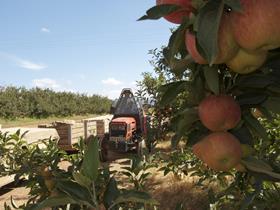
South Africa’s apple and pear industry is likely to increasingly explore new markets outside its traditional destinations, but it is also certain that the classic markets of the UK and Europe will still be of crucial importance for the industry for many years to come.
Successful long-term storage of European crops, the UK focus on home-grown apples and pears, and aggressive competition from southern hemisphere countries such as Chile has in recent years made things difficult for the South Africans. However, South African growers and exporters still have a wide choice in marketing options due to growth in Africa and the eastern markets.
“We are quietly optimistic about prospects for this season in the traditional markets for our apples, and very positive about the prospects for pears,” says Jacques du Preez, topfruit spokesman at Hortgro. “However, it is still very early in the season and we have a long way to go.”
The latest forecast indicates a total apple crop of just short of 35 million cartons, while pears are estimated at 18m. Pears are expected to be around the same level as last year, but apples could be up by around three per cent.
The optimism around pears is also related to the fact that the total southern hemisphere supply will be down this year, though on the other hand there is a predicted nine per cent increase in southern hemisphere apple exports.
One major factor influencing the South African industry this year is a complete turnaround in the exchange rate advantages the industry enjoyed last year. At the same time last year, the South African currency was trading at R22 to the British pound, but this has now been reversed to under R16, resulting in a huge reduction in returns back on the farm. However, growers and exporters who covered their proceeds forward are likely to still enjoy some exchange rate benefit despite the change.
Du Preez says the Far East and Asia are now the top receivers of South African apples, even surpassing Africa which for a few years now has been the leading sales region for the country’s apples.
In its first seasonal forecast, Hortgro reported that the harvesting season started a week later compared with the previous season. “The increase in apple volumes is mainly the result of new plantings and young orchards coming into production,” he explains. “The major varieties contributing to the growth in apple export volumes are Fuji (up seven per cent), Royal Gala/Gala (up three per cent) and Golden Delicious (up two per cent).”
Despite the growth in pear plantings over the last couple of years, volumes are expected to be in line with last year. A 16 per cent decrease in export volumes of Williams is expected due to smaller fruit size, as well as a good demand from the canning industry and a lack in demand from the northern hemisphere importing countries for this cultivar. On the other hand, export volumes of Packham’s Triumph (up three per cent), Forelle (up three per cent) and Abate Fetel (up five per cent) is expected to increase compared to the previous season.
Du Preez says South Africa will continue its promotional activities in the UK and Europe for apples and pears, indicating the importance the South Africans attach to their traditional markets.



